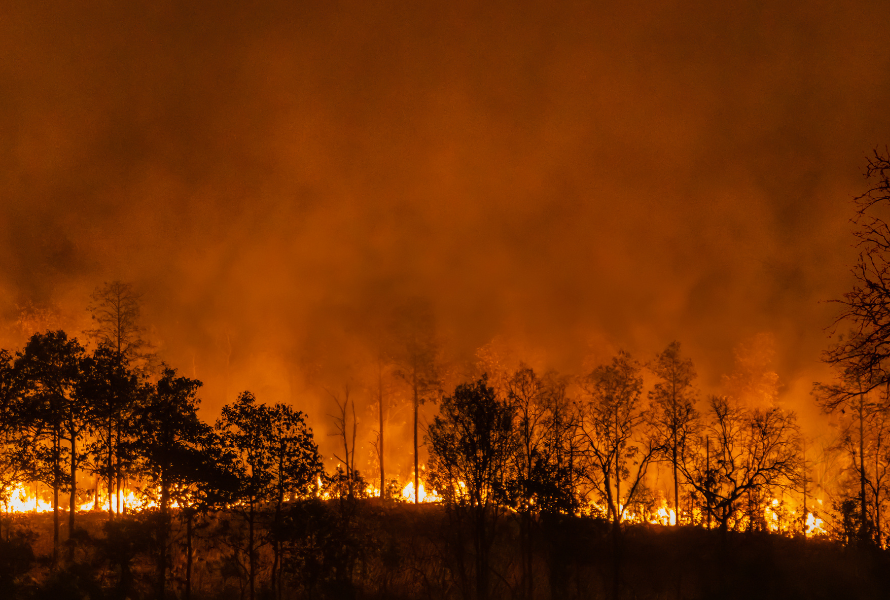So far the new year has brought us the burning of Los Angeles, and the admission by Canada’s insurance industry – after a record $8.5 billion in claims last year – that regions of Canada are becoming “uninsurable.”
And then four Canadian banks withdrew from the Net Zero Bankers Alliance.
The banks are claiming that they are still committed individually to net zero and that this doesn’t change their practices, but this is a good moment to stop and reflect on what those commitments to net zero actually mean, and whether their practices are aligning in the first place.
After all, an uninsurable Canada is one where the property market crashes, taking the bank’s multi-billion mortgage books down with it. So far, the banks appear to be sleep walking towards that eventuality, and when you factor in their massive fossil fuel financing, actually encouraging it.
The Net Zero Bankers Alliance (NZBA) was part of the Glasgow Financial Alliance for Net Zero (GFANZ), partly the brain child of Mark Carney and announced with great fanfare at the 2021 Glasgow climate summit, providing hope that private capital was now ‘on the job’ for climate transition.
Yet, scratch the surface of either the NZBA or GFANZ and you find that neither initiative commits the private sector participants to much of anything by way of specific change. This reflects Carney’s ideology captured in his seminal 2015 “tragedy of the horizon” speech where he correctly identified climate change as an existential threat to the financial industry, but then prescribed better information as the thing that will save it.
Yet, as history and basic economics shows, it is rules and incentives that shape financial behaviour, and as long as it is allowable and profitable to cook our climate, then the financial industry will help do so. Yet, this ‘better information’ thinking has also taken root with bank regulators, including our own at the Office of the Superintendent of Financial Institutions (OSFI) which has taken a disclosure approach to managing climate risk, without any evidence this will actually work.
Canada’s big six banks joined the NZBA en masse in 2021, acknowledging to shareholders that climate was a material risk to their business, and earning the expectation that they were now taking climate change seriously – which was important given that they consistently rank in the top 20 globally of fossil fuel financiers. And, some of the initial work done under the NZBA framework was useful given that it provided some reporting consistency across banks, alongside the Partnership for Carbon Accounting Financials.
The banks set about measuring their financed emissions and setting sectoral targets. Unfortunately, as our annual report cards have shown, these measurements and targets have been a dog’s breakfast, often omitting major emissions sources and setting weak ‘intensity’ targets that are unlikely to drive a change in behaviour.
If the banks are serious about net zero, it will show up in their financing numbers, shifting money away from the activities that are fueling our climate crisis, and towards those that help solve it. So far, National and BMO are the only banks that seem to be reducing some exposure to fossil fuels, with BMO the only bank setting an absolute target for oil and gas scope 3 emissions. All of the banks, though – including BMO and National – still routinely participate in financing facilities for major fossil fuel expansion projects like new pipelines and LNG. which take us in the opposite direction to net zero.
On the solutions side, the banks have set impressive-sounding “sustainable finance” commitments in the hundreds of billions of dollars, but this has been repeatedly shown to be of questionable impact. Nomenclature aside, this is mainly a profit centre for the banks, a business line to take advantage of ESG concern in the marketplace, with little measurement of emissions impact, and evidence of greenwashing along the way.
RBC’s commitment to triple renewables financing is a better target, since that can ultimately be measured and verified in MWh, although there is a question of whether the bank would have got to that number regardless given the shift in the economy. None of Canada’s banks score well on BloombergNEF’s Energy Supply Investment ratio (green vs dirty financing), with National the best of the Canadian banks, but TD coming in dead last out of the 100 global banks measured.
All the banks claim that “client engagement” will help get them to net zero and have put forth frameworks of various degrees of specificity to measure their major corporate clients’ net zero transition maturity. Yet dig deeper into these frameworks and you see the banks grading on a curve, giving the laggards a good score, since the incentive structure is to do so, to keep the money flowing.
Finally, all of the banks’ analysis shows that they need supportive public policy by governments if they are to meet their own net zero goals, so the question becomes: are they asking for it? The answer is generally “No.” While their advocacy on behalf of specific fossil fuel infrastructure projects like pipelines has faded somewhat, they are totally absent from public debates about significant climate policy. And, unfortunately, they maintain memberships in business associations that lobby against climate action.
All told, while the banks claim to still be committed to net zero despite dropping out of the NZBA, the evidence suggests otherwise. In practice, they are still doing more damage than good, even as climate risk manifests itself with greater ferocity each year, thereby undermining the conditions for successful business and successful banking.
While we would love there to be an epiphany in the Canadian banking world, we are skeptical that this will happen voluntarily. Ultimately, it is up to regulators to change the rules and incentives for the banks to follow, and until this happens we’ll continue to hear a steady stream of reassuring net zero rhetoric from the banks, with little change in their behaviour.
But given the political climate, don’t expect regulators to move quickly either. Unfortunately, it will likely take more years of mounting climate damages and a crashing insurance industry before decision makers realize that the laws of physics and chemistry trump those of the market.



